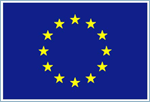
Introduction
 This graphic manual is intended to help users reproduce the European emblem correctly. It includes instructions on how to create the emblem and a definition of the standard colours. This is the European flag. It is the symbol not only of the European Union but also of Europe's unity and identity in a wider sense. The circle of gold stars represents solidarity and harmony between the peoples of Europe. The number of stars has nothing to do with the number of Member States. There are twelve stars because the number twelve is traditionally the symbol of perfection, completeness and unity. The flag therefore remains unchanged regardless of EU enlargements. This graphic manual is intended to help users reproduce the European emblem correctly. It includes instructions on how to create the emblem and a definition of the standard colours. This is the European flag. It is the symbol not only of the European Union but also of Europe's unity and identity in a wider sense. The circle of gold stars represents solidarity and harmony between the peoples of Europe. The number of stars has nothing to do with the number of Member States. There are twelve stars because the number twelve is traditionally the symbol of perfection, completeness and unity. The flag therefore remains unchanged regardless of EU enlargements.
History of the Flag
The history of the flag goes back to 1955. At that time, the European Union existed only in the form of the European Coal and Steel Community, with just six Member States. But a separate body with a larger membership - the Council of Europe - had been set up several years earlier and was busy defending human rights and promoting European culture.
The Council of Europe was considering what symbol to adopt for its own use. After much discussion, the present design was adopted - a circle of twelve gold stars on a blue background. In various traditions, twelve is a symbolic number representing perfection. It is also, of course, the number of months in a year and the number of hours shown on a clock face. The circle is, among other things, a symbol of unity. So the European flag was born, representing the ideal of unity among the peoples of Europe.
The Council of Europe then encouraged other European institutions to adopt the same flag and, in 1983, the European Parliament took up the call. Finally, in 1985, the flag was adopted by all EU heads of State and government as the official emblem of the European Union - which, in those days, was called the European Communities.
All European institutions have been using it since the beginning of 1986. The European flag is the only emblem of the European Commission - the EU's executive arm. Other EU institutions and bodies use an emblem of their own in addition to the European flag.
Symbolic Description
Against the background of blue sky, twelve golden stars form a circle, representing the union of the peoples of Europe. The number of stars is fixed, twelve being the symbol of perfection and unity.
Geometric Description
The emblem is in the form of a blue rectangular flag of which the fly is one and a half times the length of the hoist. Twelve gold stars situated at equal intervals form an invisible circle whose centre is the point of intersection of the diagonals of the rectangle. The radius of the circle is equal to one-third of the height of the hoist. Each of the stars has five points which are situated on the circumference of an invisible circle whose radius is equal to one-eighteenth of the height of the hoist. All the stars are upright - that is to say, with the one point vertical and two points in a straight line at right angles to the mast. The circle is arranged so that the stars appear in the position of the hours on the face of a clock. Their number is invariable.
Regulation Colours
The emblem is in the following colours:
- PANTONE REFLEX BLUE for the surface of the rectangle; PANTONE YELLOW for the stars.
- The international PANTONE range is very widely available and easily accessible even for non-professionals.
- Four-colour process
If the four-colour process is used, it is not possible to use the two standard colours. It is therefore necessary to recreate them by using the four colours of the four-colour process. The PANTONE YELLOW is obtained by using 100% "Process Yellow". By mixing 100% "Process Cyan" and 80% "Process Magenta" one can get a colour very similar to the PANTONE REFLEX BLUE.
- Use by third parties
The European emblem may be used only if:
there is no likelihood of the user of the emblem being confused with the European Community or the Council of Europe; the emblem is not used in connection with objectives or activities which are incompatible with the aims and principles of the European Community or of the Council of Europe. Permission to use the European emblem does not confer on those to whom it is granted any right of exclusive use, nor does it allow them to appropriate the emblem or any similar trademark or logo, either by registration or any other means. Each case will be examined individually to ascertain whether it satisfies the criteria set out above. This will be unlikely in a commercial context if the European emblem is used in conjunction with a company's own logo, name or trade mark.
|



